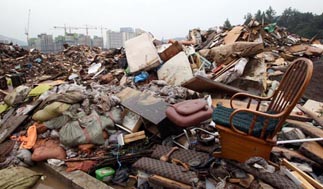In aftermath of flooding, record amount of trash

Waste from the recent downpours piles up in Hyeongchon, a village near Mount Umyeon, Seocho District, Seoul. Local district offices in Seoul didn’t separate food waste from noncompostable garbage before sending it to a landfill in Incheon, causing nearby residents to complain of the stench of rotting waste. [YONHAP]
The operator of the landfill, Sudokwon Landfill Site Management Corporation, said yesterday that it will stop receiving more garbage for the day to alleviate the crunch.
“From Saturday to yesterday, we have received about 2,000 tons just from Seoul and 500 tons from Incheon and Gyeonggi,” said Sin Yun-seon, an official from the landfill. “Because we still don’t know the exact amount of waste we’ve received, we aren’t sure when we’ll be able to dispose it all. We hope we can do it within the month.”
The landfill stayed open over the weekend to deal with the large amount of waste generated by the record-setting rain and flooding that hit the Seoul metropolitan area last week, receiving about 757 tons over the two days.
But in the haste to clean up in the aftermath of the flooding and landslides, the Seoul Metropolitan Government failed to separate food waste from noncompostable items before sending the garbage to the Incheon landfill, officials at the site said.
The failure to remove food waste beforehand - along with the summer heat - has generated a rotting stench, leading residents living near the disposal site to call in to complain, landfill officials said.
“The stench has been awful since waste from the flooded areas entered the landfill,” a 49-year-old resident surnamed Kim who lives in Seo District, Incheon, told the JoongAng Ilbo yesterday.
But the landfill operator said the situation was beyond its control.
“Local governments were supposed to sort their compostable waste from noncompostable items,” Sin said. “But they didn’t have time to do that, because local residents in their regions would complain about smelly waste.”
Meanwhile, Seoul Mayor Oh Se-hoon apologized yesterday for the city government’s response to the floods and landslides, saying that he was “sorry for not expecting the discomfort and pain of citizens.”
Oh said the Seoul Metropolitan Government would install larger underground drain pipes that can handle 100 millimeters (3.9 inches) of rain per hour. The city’s current pipes can handle 75 millimeters of rain per hour.
He added that the city will invest 5 trillion won ($4.7 billion) over the next 10 years to support areas susceptible to landslides and floods, such as installing windows and door pans in basement-level homes.
By Kim Hee-jin, Yim Seung-hye [heejin@joongang.co.kr]
한글 관련 기사 [중앙일보]
수도권매립지 수난
수해 쓰레기 넘쳐 … 음식찌꺼기까지 뒤섞여 악취 진동
곤지암·광주 하수처리장 멈춰 팔당호 수질 관리 비상
4일 오전 인천시 서구 백석동의 수도권 쓰레기매립지. 호우주의보와 함께 장대비가 쏟아지는 가운데서도 서울·경기 지역의 수해 쓰레기를 실은 트럭들이 줄을 지어 들어왔다. 경인 아라뱃길 북쪽의 제2매립장에서는 토사에 뒤범벅이 된 가재도구며 옷가지·책 등의 수해 쓰레기를 파묻느라 중장비들이 굉음을 내고 있었다. 이곳에 지난달 말 일어난 수도권 물난리 이후 연일 산더미 같은 수해 쓰레기가 몰리면서 심한 악취가 나는 등 몸살을 앓고 있다.
수도권매립지에서는 누적 강우량이 15㎜를 넘어서면 쓰레기를 받지 않 는다. 매립장 주변은 땅이 물러 비까지 내리면 사고가 우려돼서다. 그러나 지금은 비상체제에 들어가 쓰레기를 받고 있다.
매립지 인근에 사는 김모(49·인천시 서구 경서동)씨는 “수해 폐기물이 본격 들어오기 시작한 지난 주말부터 악취가 심해졌고, 토양도 심하게 오염될 우려가 커졌다”고 말했다. 원래 매립장에는 일정 기준 이상으로 젖은 쓰레기와 음식물 쓰레기는 반입이 되지 않는다. 젖은 쓰레기는 물기를 빼야 한다. 심지어 음식물이 묻은 쓰레기도 음식물을 제거해야 반입된다. 현재는 이런 구분 없이 쓰레기가 섞여 들어온다.
주변지역 주민들은 “수해 쓰레기 때문에 이곳 토양과 지하수가 더 오염되는 게 아니냐”고 말했다. 수도권매립지에는 지난달 30일부터 4일까지 모두 3100여t의 수해 쓰레기가 반입돼 매립됐다. 피해가 심했던 서울 서초구에서만 600여t이 실려와 가장 많은 양을 기록했다. 경기 지역에서는 광주·남양주·양주·포천시 등에서 800여t이 실려 왔다. 반입관리실의 신윤선 부장은 “쓰레기 처리를 친환경적이고도 체계적으로 해야 하지만 지금은 비상 상황이라 어쩔 수 없다”면서 “전체 매립량에 비하면 수해 폐기물은 적은 분량”이라고 말했다.
수도권의 상수원인 팔당호 수질관리도 위험에 처했다. 지난달 27일 폭우로 광주와 곤지암의 하수처리장이 침수돼 가동이 중단됐기 때문이다. 이로 인해 매일 3만6000t의 하수가 경안천과 곤지암천을 통해 팔당호로 흘러 들어가고 있다. 곤지암 하수처리장은 긴급 복구를 해 8일부터 가동에 들어갈 예정이다. 하지만 광주 하수처리장은 앞으로 두 달가량 가동이 어렵다. 이에 따라 매일 1만3000t가량의 하수가 정화되지 못하고 팔당호로 흘러 들어가게 된다. 김태한 경기도 팔당수질개선본부장은 “긴급 복구에 들어가 다음 달 말까지 복구하겠다”고 말했다.










with the Korea JoongAng Daily
To write comments, please log in to one of the accounts.
Standards Board Policy (0/250자)